Difference Between Deep Groove Ball Bearing and Tapered Roller Bearing
Deep groove ball bearings and tapered roller bearings are two common types of bearings, which are widely used in a variety of industries. They are different in structural appearance, load capacity, service life, and application areas. Understanding the difference between them for the correct selection of bearings is of great significance, and can effectively improve the service life and performance of mechanical equipment.
Different Structure Appearance
Grooved ball bearing is the most common kind of rolling bearing. Its roller is rolling in the spherical groove, so it is called deep groove bearing. The structure is simple, resembling a sphere, consisting of an inner ring, an outer ring, balls, and a cage. Where these balls are usually made of steel or ceramic and are held in place by a cage to prevent them from contacting each other, the inner and outer rings have the same diameter.
While tapered bearings are roller rolling on a tapered surface. The roller is tapered, so it is called conical roller bearings. The shape is similar to a cone, with an inner ring, an outer ring, a tapered roller, and a cage. The inner and outer rings have different diameters.
Deep groove bearings come in a variety of sizes and configurations, including single-row, double-row, and sealed designs. And taper bearings are available in single-row, double-row, and four-row configurations, which can be adjusted or preloaded to provide optimal performance and minimize clearance or backlash.

Different Load Capacity
Radial ball bearings mainly withstand radial loads, and can also withstand axial loads, but withstanding axial load capacity is weak.
Tapered roller radial bearings can withstand both radial and axial loads due to their tapered design and can adjust the front and rear clearance of the bearings. So the application scenario can withstand the higher composite load.
Different Service Life
The inner and outer rings of tapered roller bearing systems are also tapered to withstand both radial and axial loads, which allows the load to be properly distributed on the bearing surfaces, so they have a longer service life than deep groove radial ball bearings. This design helps to reduce friction and heat generation, which improves efficiency and extends bearing life.
Different Application Areas
Deep groove bearings with high limit speed are not resistant to impact and are not suitable for bearing loads. They are suitable for some high-precision machinery, such as motors, instruments, meters, pumps, household appliances, etc. These mechanical devices usually only bear radial loads and need to have high precision and low coefficient of friction.
Conical roller bearings are suitable for large mechanical equipment, such as metallurgical mills, engineering machinery, railroad vehicles, ships, mining machinery, agricultural machinery, and so on. This mechanical equipment is usually subjected to composite loads and vibration loads and needs to have a strong axial and radial bearing capacity.
In summary, tapered roller bearing units and radial deep groove ball bearings are different in the scope of use, structural characteristics, load-carrying capacity, and service life. It is necessary to choose the appropriate bearing according to the specific conditions of use and demand.

